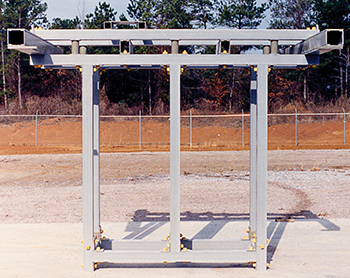Case Study: Fiberglass Plating Line Cradle Replaces Steel in Corrosive Process
 Bundy Tubing of Warren, Michigan, a steel tubing manufacturer, uses an all-fiberglass plating line cradle (or housing) to support conveyor rolls in the cleaning cycle of a continuous strip plating operation. Highly corrosive muriatic acid is used in the process preceding the cleaning cycle requiring corrosion resistant materials in all equipment in the operation. The fiberglass structure replaces structures fabricated of steel wrapped in fiberglass cloth and resin, which required continuous repair and had a service life of less than five years. The first EXTREN® fiberglass plating line cradle, sold and fabricated by Fibertron of Bessemer, Alabama, has been in service for over a year and shows “no sign of deterioration and has required no repair or maintenance,” according to Victor Bodek, Process Engineer at Bundy Tubing. “The fiberglass performed better than all previous materials used in this application.”
Bundy Tubing of Warren, Michigan, a steel tubing manufacturer, uses an all-fiberglass plating line cradle (or housing) to support conveyor rolls in the cleaning cycle of a continuous strip plating operation. Highly corrosive muriatic acid is used in the process preceding the cleaning cycle requiring corrosion resistant materials in all equipment in the operation. The fiberglass structure replaces structures fabricated of steel wrapped in fiberglass cloth and resin, which required continuous repair and had a service life of less than five years. The first EXTREN® fiberglass plating line cradle, sold and fabricated by Fibertron of Bessemer, Alabama, has been in service for over a year and shows “no sign of deterioration and has required no repair or maintenance,” according to Victor Bodek, Process Engineer at Bundy Tubing. “The fiberglass performed better than all previous materials used in this application.”
| TECHNICAL DATA |
|---|
| Product: Plating Line Cradle |
| Process: Pultrusion |
Materials:
|
Sizes: EXTREN® structural shapes:
|
| User: Bundy Tubing |
| Fabricator: Fibertron, Inc. |
Subsequently, a second fiberglass plating line cradle was purchased from Fibertron and installed, and fiberglass replacement of other steel structures is planned for the plant. “From what I’ve seen of fiberglass in this plant, I wish this material would have been available in 1969 when we put in the plating line,” said Bodek who cited many other recent fiberglass applications including fiberglass grating, guardrails, walkways, etc.
The fiberglass plating line cradle shown here is 13’6" high x 16' long x 4’6" wide and will have six rollers mounted on the framework (total weight 1800 lbs.) and be hung in a pit by the top square tube members shown here. Plate in the middle of the structure separated two different rinse processes of fresh water and recirculated water.